Truck references and analogies have been a surprisingly frequent
motif in the Apple-oriented blogosphere lately. Last Friday, T-GAAP's
E. Werner Reschke posted a screed entitled Hi,
My Name Is Werner. And I Am a Truck, riffing on a Steve Jobs
analogy dating back to 2010 proposing that tablet computers like the
iPad are like cars - good for the sort of computing and communicating
most of us do most of the time - while PCs (in this context,
traditional desktop and laptop computers, whether Mac or Windows) are
best for doing a lot of heavy lifting and performing special functions
in which they're increasingly being used like trucks - only
occasionally to be called upon when extra utility and power are
required.
"When we were an agrarian nation, all cars were trucks," Jobs is
cited musing. "But as people moved more towards urban centers, people
started to get into cars. I think PCs are going to be like trucks. Less
people will need them."
Aside from the grammatical blooper (he should have said "fewer" not
"less"), I don't think the analogy holds water that well. Is Jobs
oblivious to the fact that more trucks are being used for daily
transportation in urban settings by noncommercial users than ever
before in history? However, these sorts of references resonate with me
as a crossover computer/automobile aficionado.
Strictly speaking, Werner Reschke says he's not really a truck, but
in Steve's analogy he'd be more of a truck driver, and even though he
uses a car (an iPhone 4), he has yet to find a need or feel a real
desire to buy an iPad. When he needs to be working or computing while
mobile, his MacBook Air
is an easy carry-along, while for browsing or email on the go, the
iPhone does great, so he can't see where the iPad fits into his life,
since it duplicates his MacBook Air's functions to a degree but still
doesn't do all he needs a "computer" to be able to do. Given his
particular needs, Werner says he's essentially a truck guy and likely
to use a "truck" computer until he retires.
I think many Apple fans are finding themselves torn between the
car/truck computing paradigms these days, and actually, the dichotomy
is one that affects the actual world of four-wheeled cars and trucks
these days too. Personally, I own both a truck and several cars, and I
wouldn't want to have to settle for just one or the other. On the other
hand, I've up to now been a thoroughgoing trucker when it comes to
computing, having neither an iPhone (no wireless cell provider support
for the iPhone where I live) or an iPad, although I'm seriously
wavering on the latter.
2011 Ford F-150 Eco-Boost "A Testimony And Validation To The
Macintosh Way"?
"It never fails," says AutoSpies' Agent 001. "When I have a
car I want a truck and when I have a truck I want a car . . .
Can you relate to this?"
I can indeed.
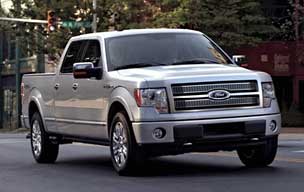 "[If
you've] been reading on AutoSpies.com, you know Agent 001 just traded
the 2010 911S for a 2011 BMW 335d," he says. "But what you don't know
is that about 45 days ago I quietly added the all new 2011 Ford F-150
XLT Supercrew Eco-Boost 4x4, 157" long bed to the stable."
"[If
you've] been reading on AutoSpies.com, you know Agent 001 just traded
the 2010 911S for a 2011 BMW 335d," he says. "But what you don't know
is that about 45 days ago I quietly added the all new 2011 Ford F-150
XLT Supercrew Eco-Boost 4x4, 157" long bed to the stable."
Agent 001 says that the 2011 Ford F-150 pickup, especially with the
fuel-efficient and astonishingly powerful new Eco-Boost V6 engine, is a
testimony and validation to the Macintosh way of taking something
really good, endlessly perfecting it over time, and delighting and
enchanting the customer.
Agent 001 loves his F-150. I completely understand. I'm not a big
fan of its exterior styling (although the inside is especially
nice).

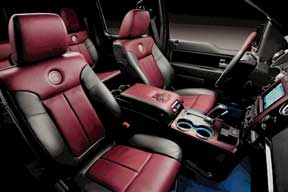
Interior views of Ford F-150 Supercrew.
More on truck styling in a moment, but in my estimation as a
lifelong automobile enthusiast and critic, the current Ford F-series
pickup trucks are the class of the field, and it's not for nothing that
Ford's F-series has been not only the best-selling pickup truck for
some 45 years, but more often than not the best-selling vehicle
in North America overall.
As Agent 001 observes, "If all American vehicles were this well
thought out and performed as well, Toyota and Honda would still be a
blink in the night."
He advises that pretty much the best way to see how good this truck
is and how badly it slaps the others is to watch the torture test video
series about the new Eco-Boost six-cylinder in the F-150 on the
Ford website.
I concur. Prepare to be impressed.
Torture Test
Even if you're not currently shopping for a truck, you really want
to check this out. Or, in case you don't have the 10 minutes or so to
spare downloading and viewing the six video clips, here are the broad
strokes: Ford engineers pulled 3.5 liter Eco-Boost six-cylinder serial
number 448AA off the production line in Cleveland, and proceeded to run
it for the equivalent of 150,000 miles at high load on a dynamometer,
simulating alternating extremes of high and low temperatures. Then they
dropped the engine into an F-150 and drove it 1,900 miles, including
over the Rocky Mountains, to Oregon, where they subjected it to
skidding 55 tons of logs (some of them weighing more than the truck
itself) up a steep grade dragging on the ground. That test successfully
executed, they drove the truck 3,300 miles back across the country to
Homestead-Miami Speedway in Florida where they ran it flat-out around
the circuit for 24 hours, towing a trailer loaded with two NASCAR stock
cars for a total trailer weight in excess of 11,000 pounds, stopping
only for fuel and tire changes. Then back across the country yet again
to participate in a "torque sprint" against Dodge RAM and a Chevy
Silverado pickups powered by 5.7 and 5.3 liter V8 engines respectively,
towing 9,000 pound trailers up a 10-mile grade, in which the Eco-Boost
V6 dusted both V8 competitors by substantial margins. Then down to
Baja, Mexico, where Eco-Boost 448A was removed from the F-150 and
dropped into Mike MacCarthy's custom-built Ford pickup off-road racer
to run in the grueling Baja 1000 at speeds up to 100 MPH, again
finishing with flying colors. The engine was finally shipped back to
Detroit after the equivalent of 165,000 miles of largely brutal abuse,
where it checked out on the dyno as still exceeding its advertised
torque and horsepower specifications. Finally 448AA was taken to the
North American Auto Show for a public teardown, in which it was
examined and measured for wear, with the critical internal specs. found
to still be within production tolerances.
As I said, impressive, and it should put to rest any doubts about
the turbo engine's ruggedness and dependability, about which I admit to
having been a cautious skeptic.
Agent 001 is also stoked on Ford's SYNC technology, with which he
says that even if you don't buy the full nav system, you still get a
really good and useful (although only text directional and voice)
navigation solution.
Ergo, just hit one button on the steering wheel, say "SYNC
services", and it makes a call and voice prompts you through the whole
thing so you don't have to remember a bunch of specific voice commands.
It then downloads the nav instructions into your phone, and built-in
Bluetooth shows it through the text display in the center stack, with
voice instructions coming through the sound system. Pretty amazing
considering that the SYNC option costs only $275 and requires no
monthly subscription.
You can read Agent001's 2011 Ford F-150 Eco-Boost review, profusely illustrated with great
photos of the F-150 from San Diego and the surrounding areas on
AutoSpies.com.
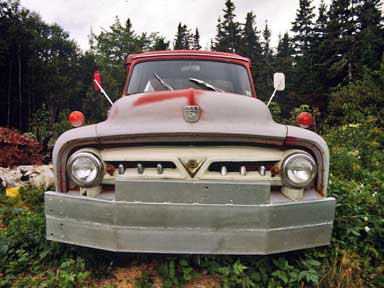
1953 Ford F-200.
Pickup Truck Aesthetics
I'm a big fan of pickup trucks, but as I alluded to above, it's more
often than not in spite of rather than because of the way
they look. There have been exceptions, of course. In my estimation the
quintessence of what a proper light-duty truck should look like is
embodied in Ford's 1949
through 1956 F-series pickups. That may be partly due to my time
and very early impressions, since I lived through the last six years of
that interval and can't remember when I wasn't a truck fancier.
However, there were lots of other trucks around when I was a kid and I
never thought any of the others looked as good as the Ford.
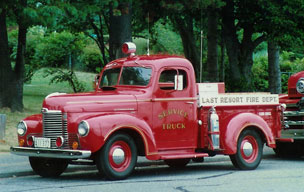
1949 International Harvester pickup.
First runner-up, I guess, would be post-World War II International
Harvester pickups up to 1968, after which IH threw in the styling towel
and went with a slab-sided three rectangular box un-design that
looked like it could've been drawn by a creativity-challenged
six-year-old. Perhaps not coincidentally, they were the last series of
pickups before IH abandoned that market segment.
I Know What I Like
Appreciation of style is a subjective thing. The average person has
little or no knowledge about the technical aspects of design, but just
about everyone knows what they like and don't like aesthetically.
However, while there is no definitive "right" or "wrong" in
stylistic aesthetics, there is often a fair bit of consensus. For
example, most people seem to think Apple does a consistently better
than decent job with the industrial design of its hardware products. I
don't think I've ever heard anyone - not even hard-bitten PC partisans
- say they don't like the looks of the MacBook Air. Aluminum unibody
MacBook Pros also get pretty unanimous accolades. I love the look of my
Late 2008 Unibody
MacBook, although the white version of the iPad 2 is the first tablet computer
iteration that's really appealed to me.
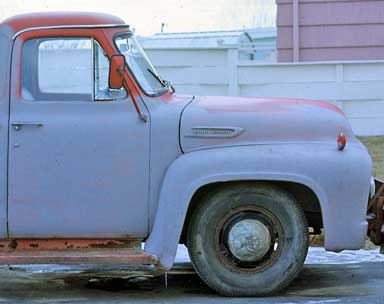
1953 Ford F-250.
Back to Pickups
Back to pickups. I've only owned one of those classic-era F-series
Fords, a 1953 three-quarter ton F-250 that was an amazingly satisfying
highway vehicle as well as a formidable hauler.
However, I spent a lot of time in 1950 and 1953 F-100s belonging to
friends. The '53 had the indignity of a swapped-in General Motors
inline six cylinder mill, but it was still a nice truck to drive and
look at. My own '53 F-250 and the 1950 F-100 both had classic Ford
flathead V8s, a delightful powerplant whose smoothness and quietness
wouldn't have been out of place in a luxury car.
Unfortunately, Ford pickup styling went from sublime to less than
mediocre literally overnight with the 1957 model year, and it stayed
that way through most of the 1960s, 70s, '80s, and '90s.
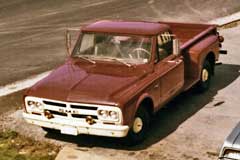
1969 GMC pickup.
Not that the competition was much better. General Motors had a brief
renaissance of pickup truck good looks from 1967 through 1972, after
which they reverted to mediocrity.

1977 Dodge D-100.
The best-looking trucks of the subsequent period IMHO were the
Dodges of 1973 through 1993. I owned a 1977 D-100 whose styling I
genuinely admired and never got tired of. The best you could say of
contemporaneous Fords and GMs styling-wise was that they were at least
unpretentiously utilitarian in appearance.
The Next Phase
Not so the next phase, ushered in by Chrysler with its "big rig
look"
1994 Dodge RAM pickups. From a marketing perspective, this
departure paid off big time for Chrysler, which nearly doubled its
pickup truck market share after the restyling, but it didn't appeal to
me in the slightest. Adding insult to injury, aesthetically speaking,
Chrysler had an extremely attractive, clean-looking, and original
pickup design in the works that was abandoned and superseded by the
Kenworth wannabe caricature design. At least the first iteration was
done with a modicum of restraint.
Meanwhile, General Motors had gone with a more car-like styling on
its 1988 pickups, and today, two generations on, the Chevy and GMC
pickups of 2011 remain derivative of that restyling, with, in my
estimation, the middle-generation being the most successful of the
three takes. A friend of mine has one of the current model Chevy
Silverados, which I think is awkwardly and pointlessly ugly.

Ford F-250.
Ford, on the other hand, did a relatively pleasant and original
restyle of its pickups in 1997, featuring sleek, rounded lines, and
that survived several facelifts before finally capitulating to the
Dodge-initiated trend of making its trucks look like Transformers
cartoon caricatures with a major restyle in 2009. The current Ford
Super Duty F-250 and F-350 models are the most extravagantly
exaggerated examples of the genre yet. I thought Peter Egan of Road
& Track magazine captured the dynamic nicely in his comment
that having one of these late-model pickups in his rear view mirror
puts him in mind of the living room fireplace mantelpiece following him
down the road.
Frankly, I think the current batch of full-sized pickups from all of
the Detroit big three are all ugly, the Ford F-150 being the
best-styled of a mediocre lot, with the Japanese (albeit
American-built) competition from Toyota and Nissan even more
nondescript, but at least inoffensive. The midsized and
getting-long-in-the-tooth Dodge Dakota is probably the best looking
pickup from the Detroit big three currently. However, styling
notwithstanding, if I were shopping for a new pickup today, I would
head directly to my nearest Ford dealership with no other stops
necessary.
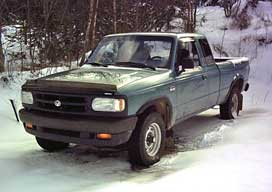
Mazda B-4000.
In reality, my own current pickup is a 1994 badge-engineered Mazda
clone of the long-running Ford Ranger compact pickup that I definitely
didn't buy for its looks. For me, a real truck has a plain vinyl bench
seat, rubber floor mats you can clean with a garden hose, rear pontoon
fenders, running boards, and a manual stick shift.
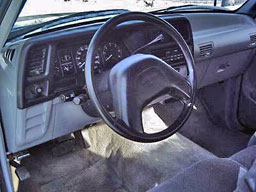
Mazda B-4000 dashboard.
My Mazda has an interior that wouldn't be out of place in a midsize
Japanese sedan, with pile carpet not only covering the floor but
halfway up the insides of the cab, reclining seats with a fold-down
armrest, and an automatic transmission. Indeed, it bears noting that
Ford currently sells no F-series pickups with manual transmissions at
all, although the TorqShift 6R six-speed automatic transmission for
2011 features a manual mode.
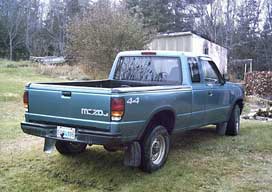
Mazda B-4000.
Interestingly, despite its totally aimless styling and car-like
interior, my Mazda has been a surprisingly good truck. In terms of size
and carrying capacity it actually reminds me of those early 1950s
F-100s.
If I had to choose one or the other, I would go with a truck, and
the same holds true for the computer analogy. I can't imagine being
able to get along without a reasonably full-featured laptop, although a
"compact truck" like a MacBook Air would likely prove more than
adequate for my needs, especially if the price of larger-capacity SSD
drives eventually climbs down from the stratosphere.
As for whether I can live happily with a "car" computer, I'm almost
decided to take the plunge and find out with an iPad 2.

 "[If
you've] been reading on AutoSpies.com, you know Agent 001 just traded
the 2010 911S for a 2011 BMW 335d," he says. "But what you don't know
is that about 45 days ago I quietly added the all new 2011 Ford F-150
XLT Supercrew Eco-Boost 4x4, 157" long bed to the stable."
"[If
you've] been reading on AutoSpies.com, you know Agent 001 just traded
the 2010 911S for a 2011 BMW 335d," he says. "But what you don't know
is that about 45 days ago I quietly added the all new 2011 Ford F-150
XLT Supercrew Eco-Boost 4x4, 157" long bed to the stable."











